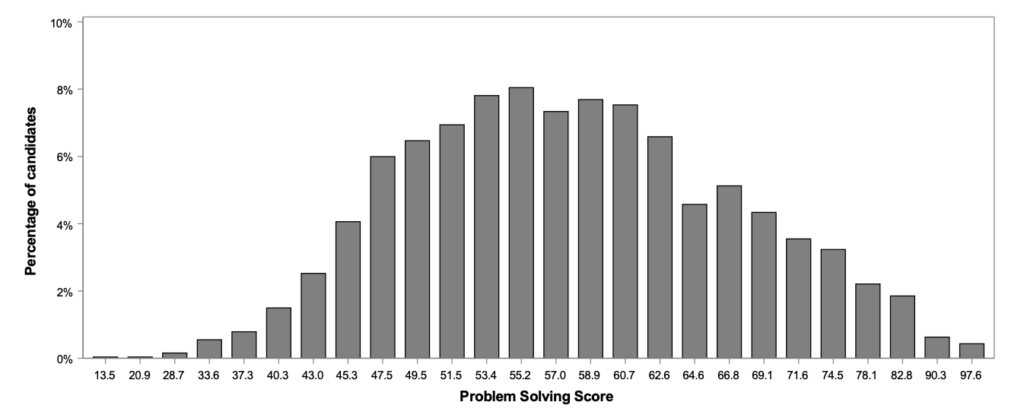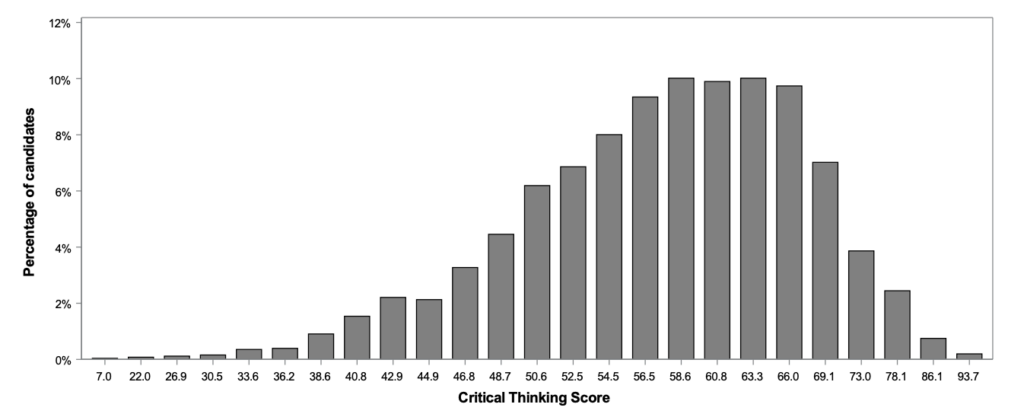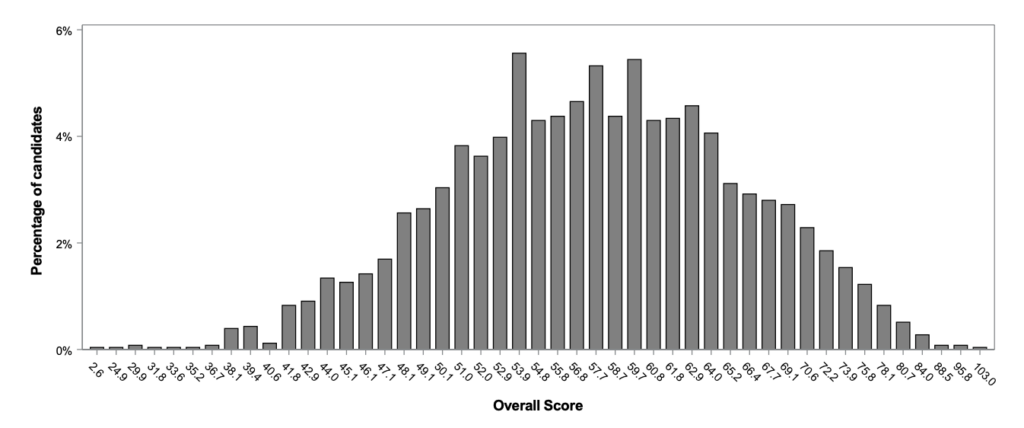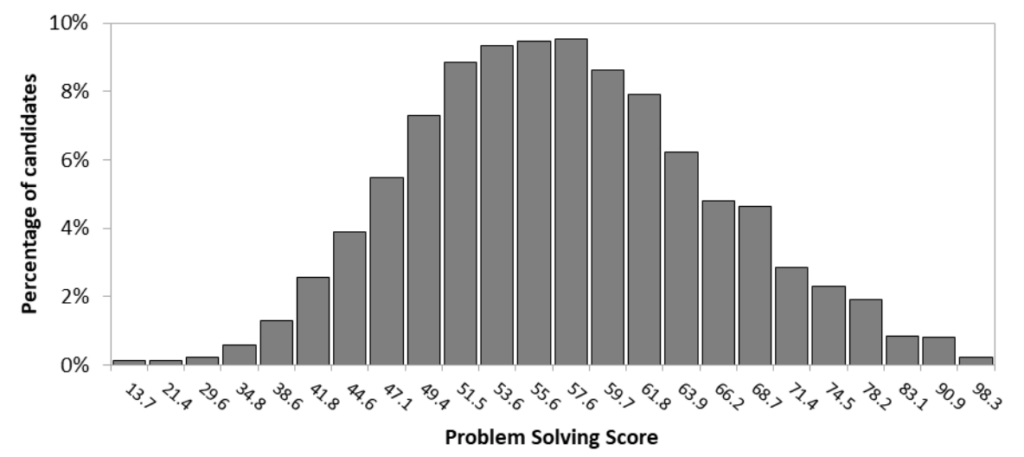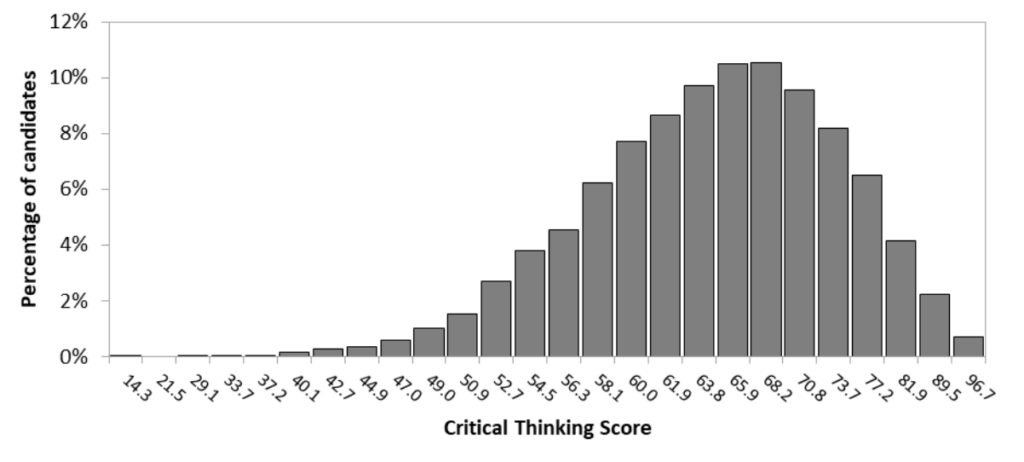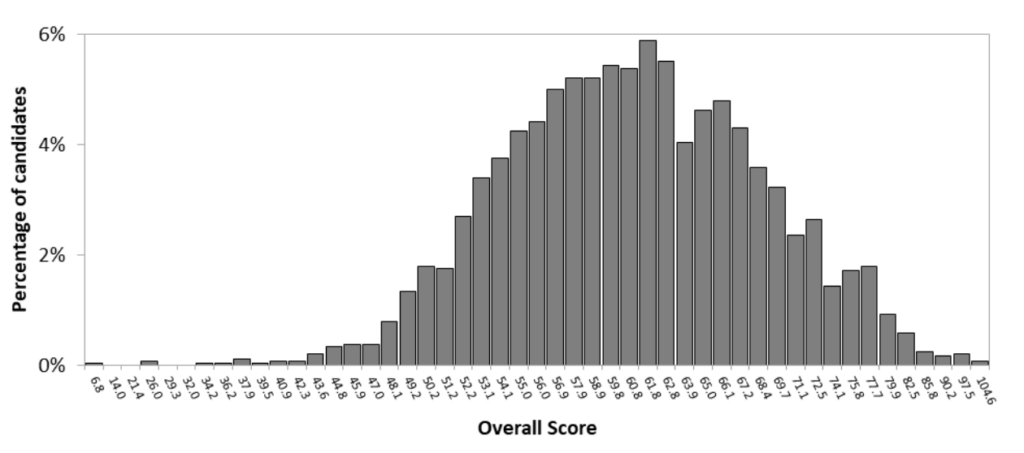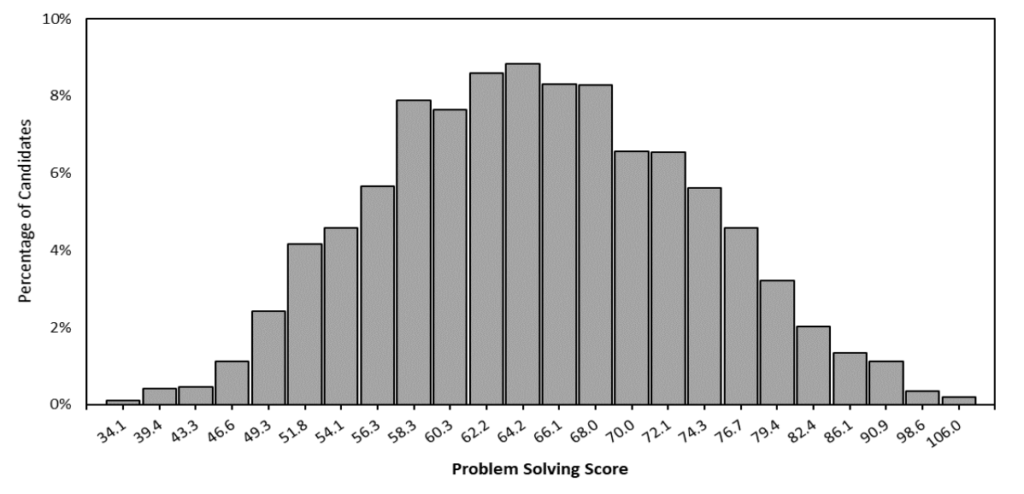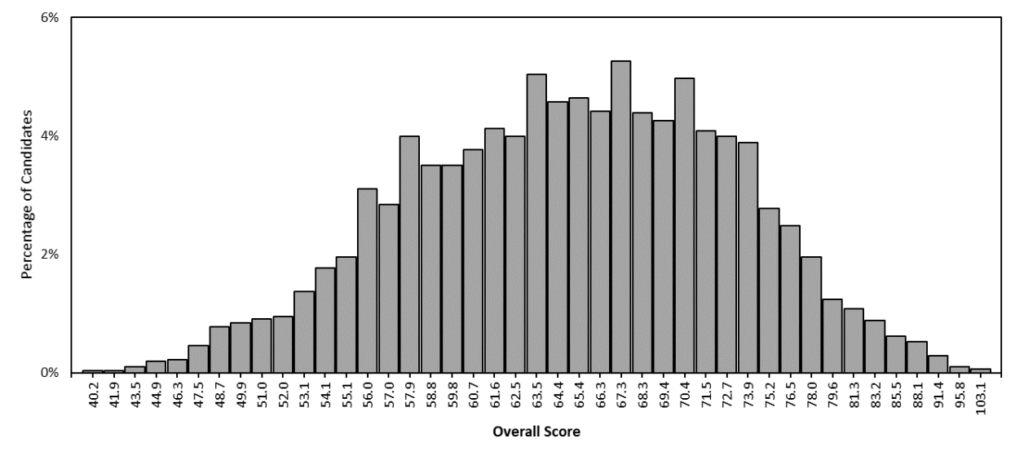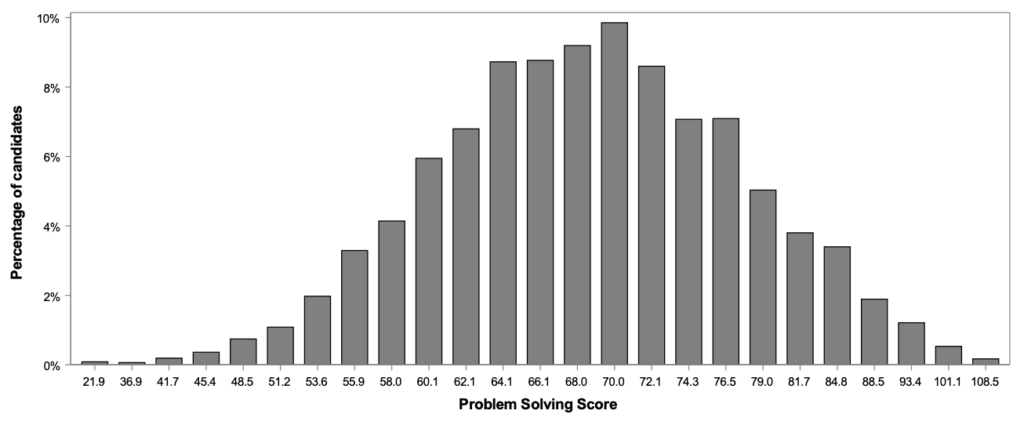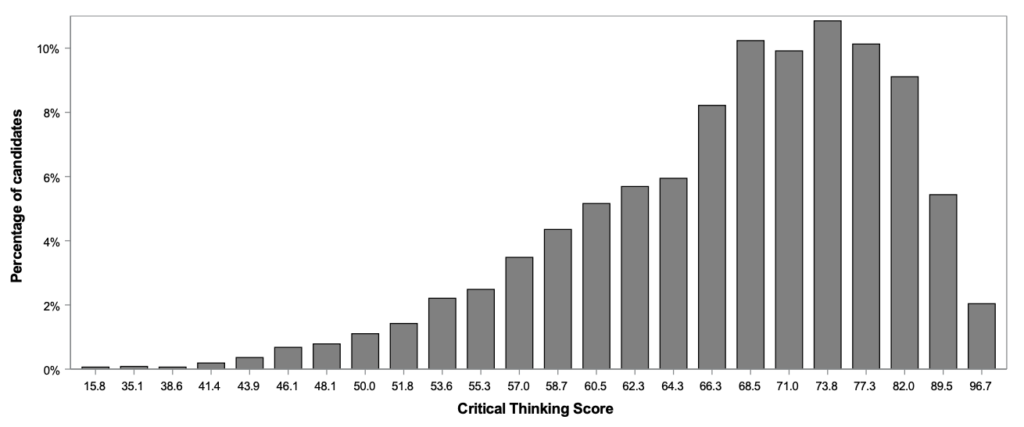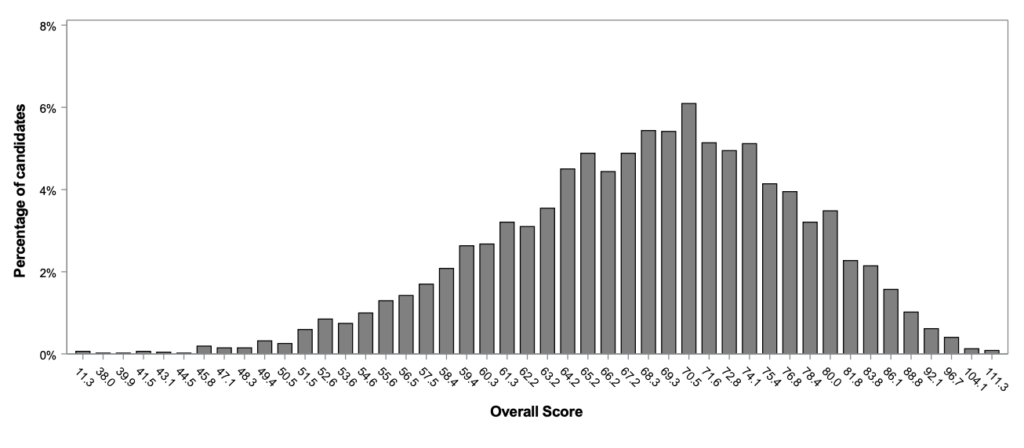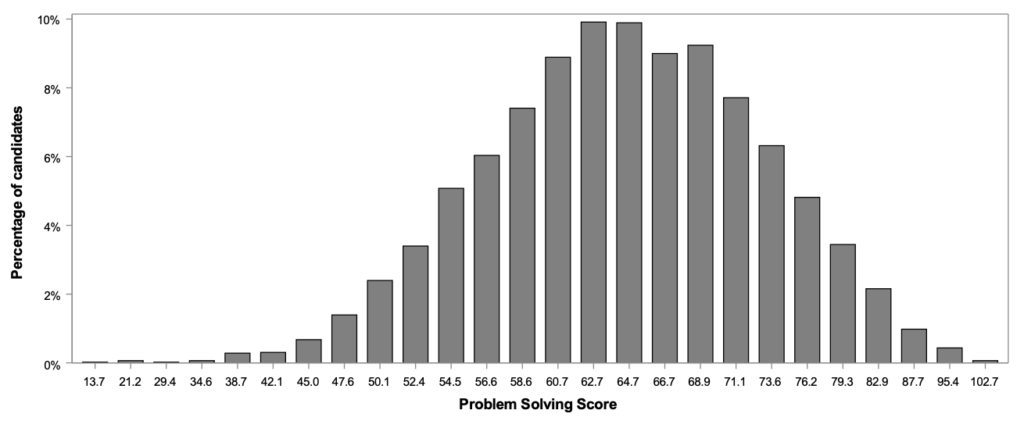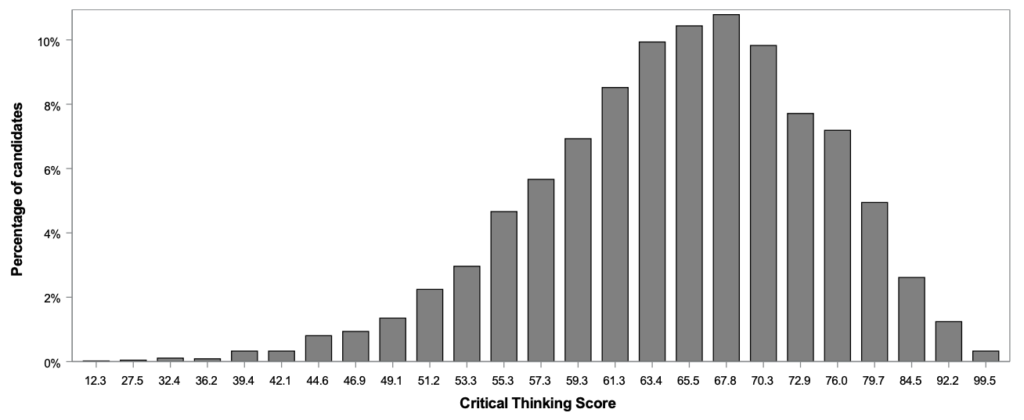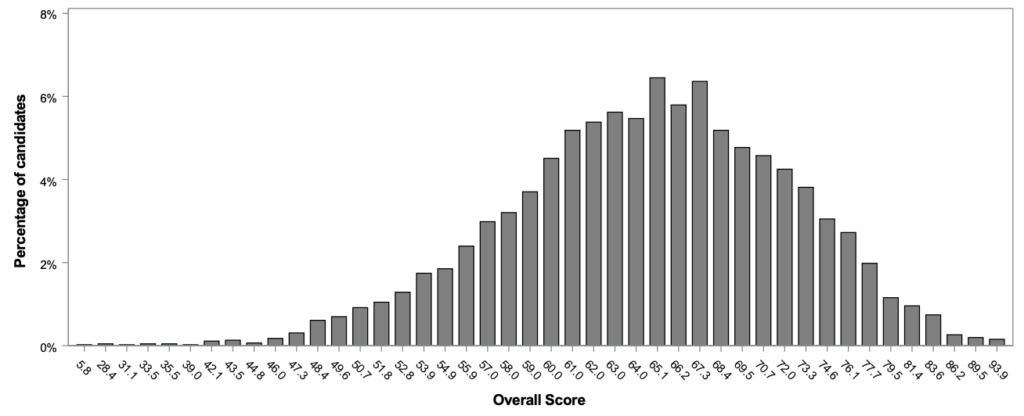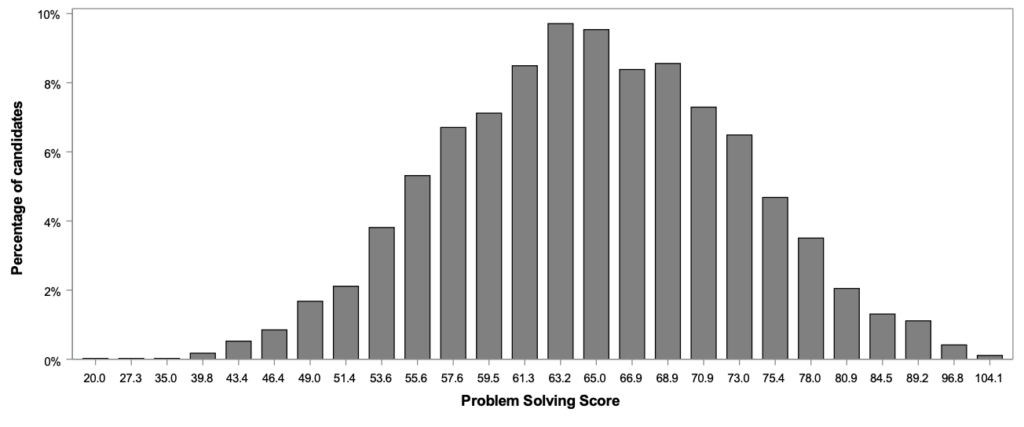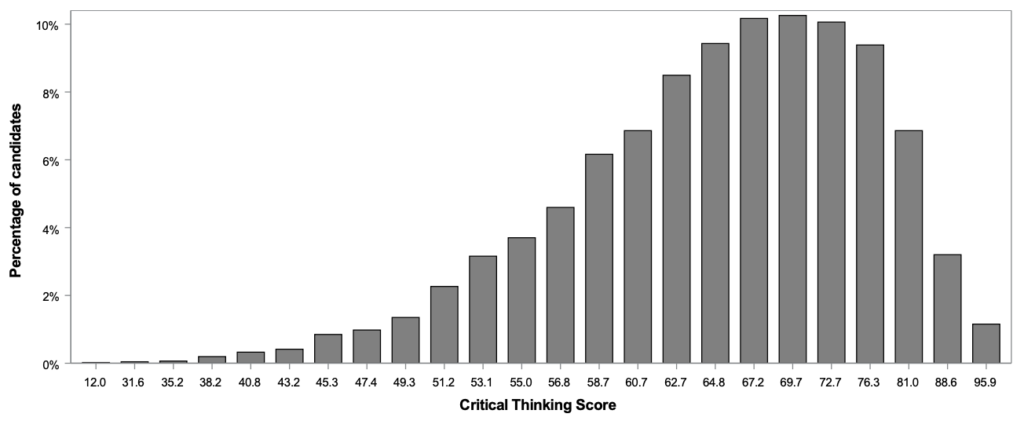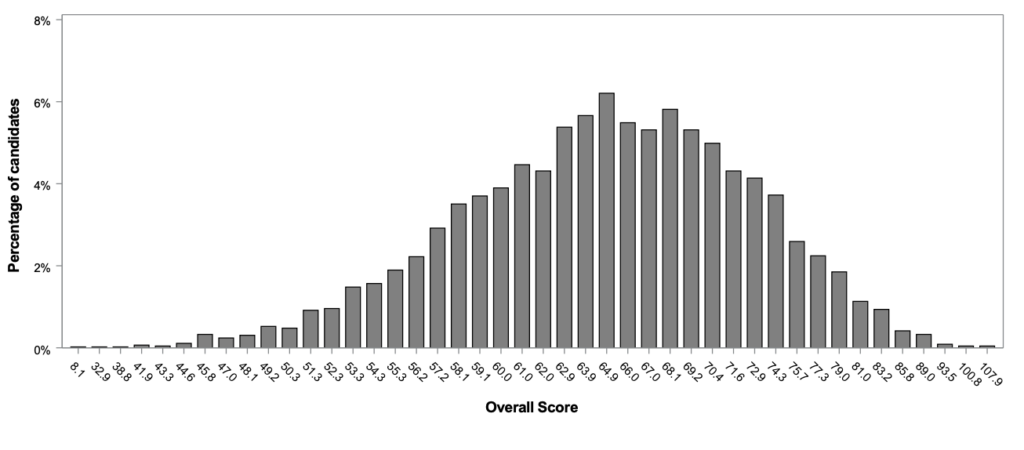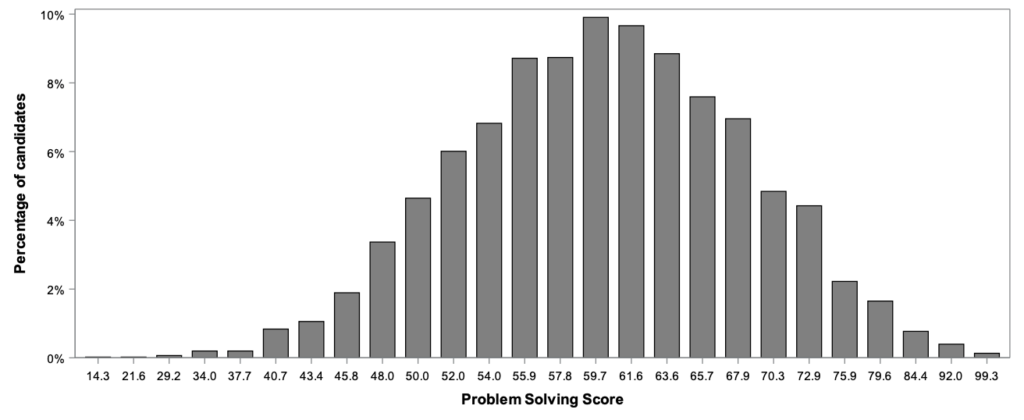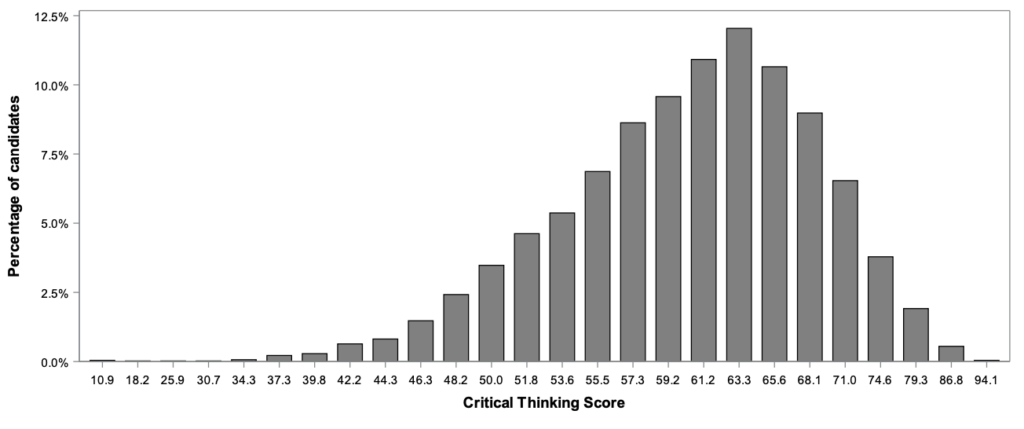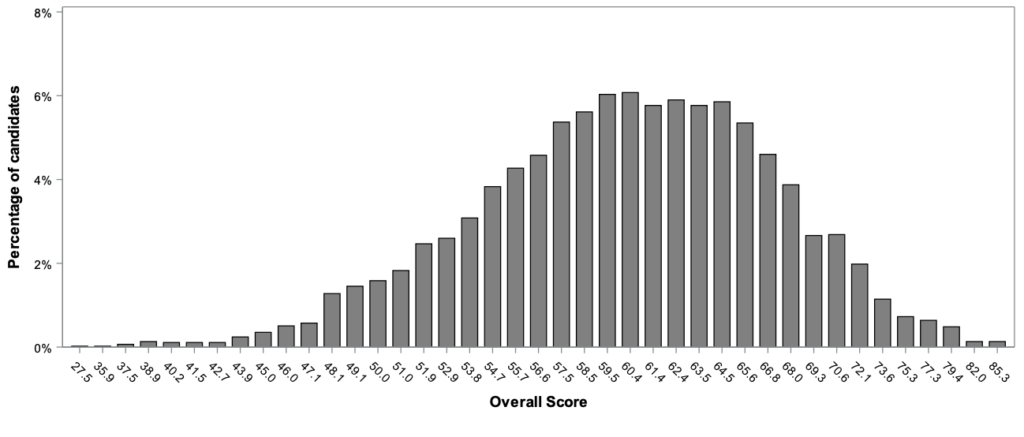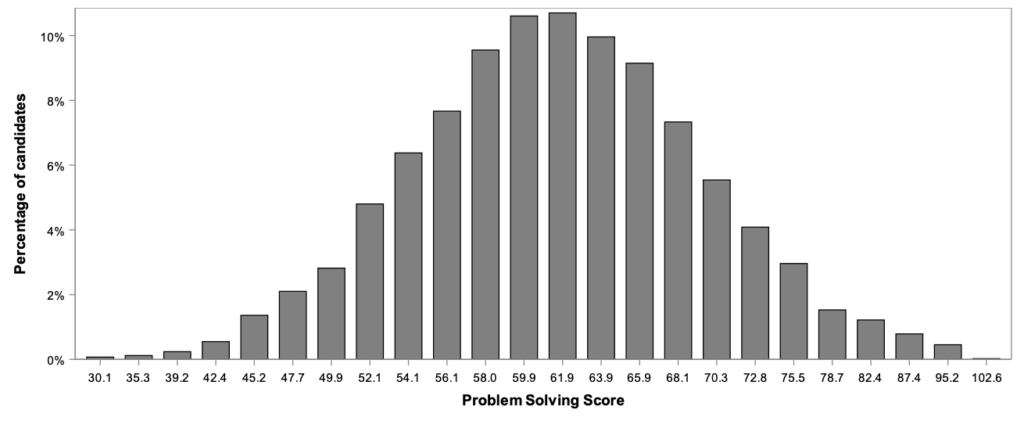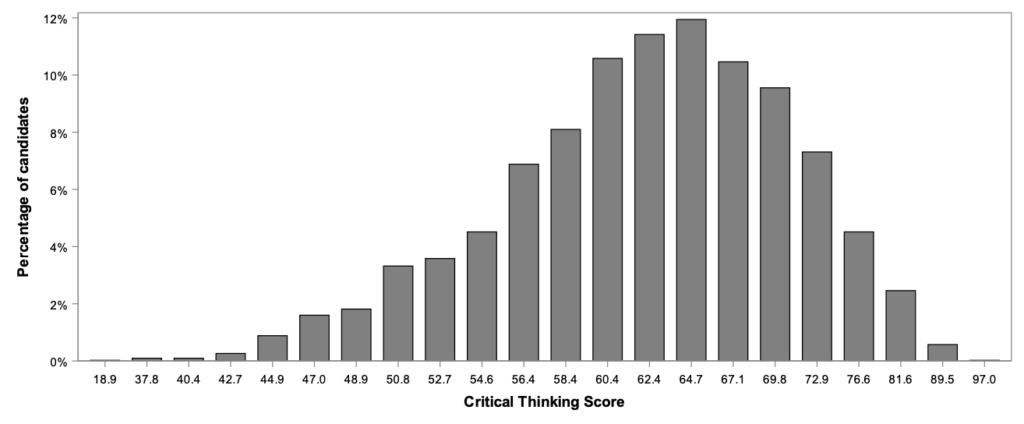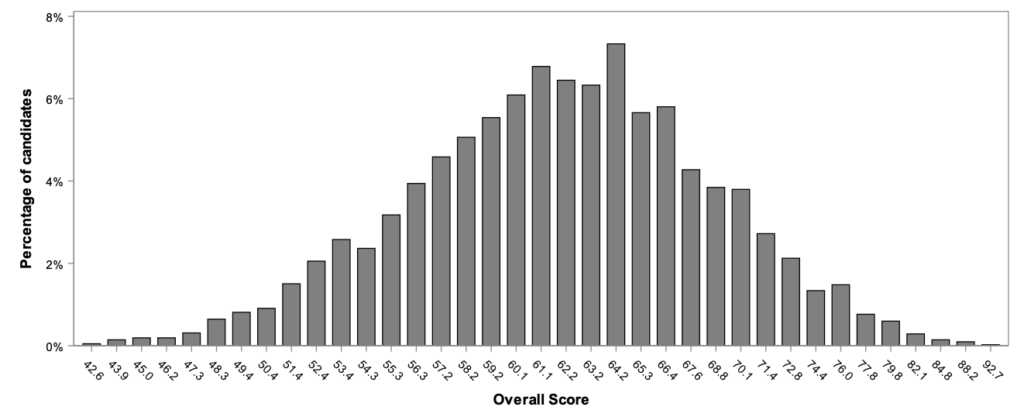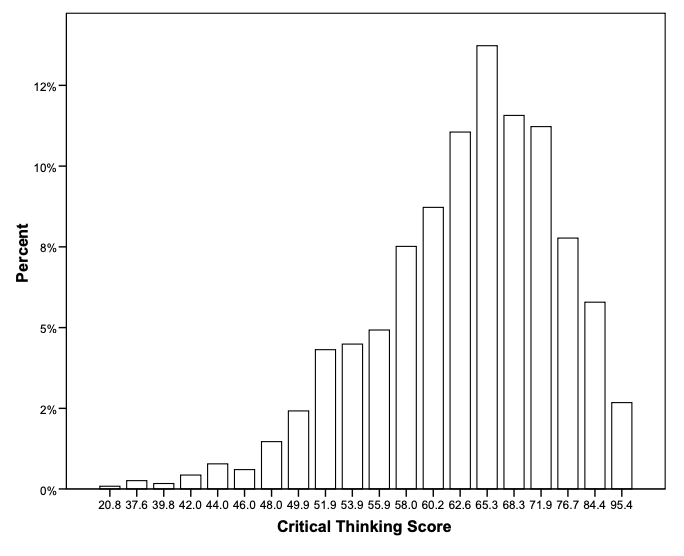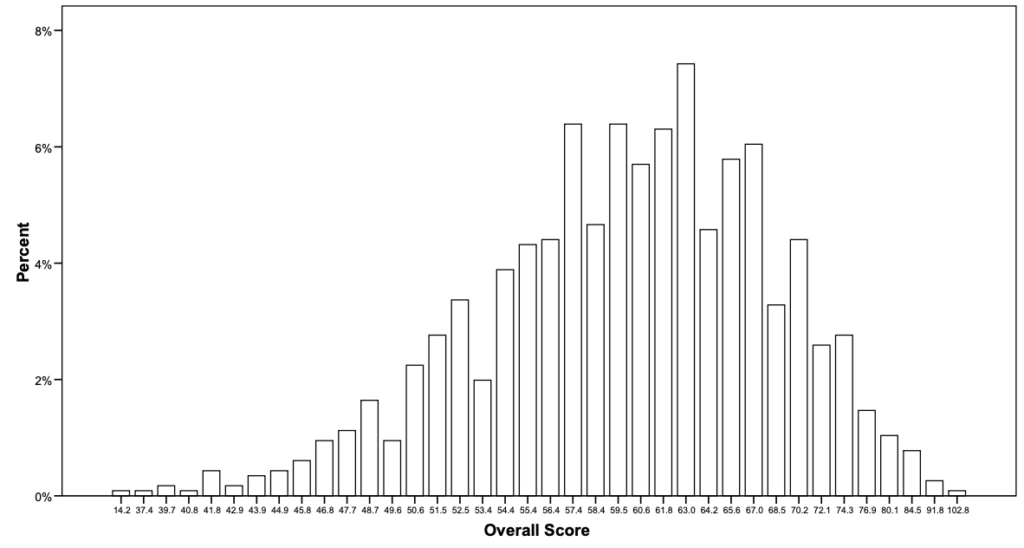YOUR ULTIMATE GUIDE
Oxford TSA Results 2024 - The Definitive Guide to your TSA Score
Written by: Matt Amalfitano-Stroud
The TSA Oxford is a very general exam used for a wide variety of courses, so your result will not only help you in your application but provide some idea of how well you manage problem-solving and critical thinking. Therefore, it’s important to understand how these results are calculated, what they’re used for and how they could affect your application.
1/4
HOW IS THE TSA SCORED?
Let’s start this guide by finding out how the Thinking Skills Assessment (TSA) is scored and what those scores actually mean.


The TSA itself is made up of two sections, Section 1 and Section 2. These two sections have a different question structure and thus, a different marking scheme.
TSA Section 1 Scoring
Section 1 of the TSA tests Critical Thinking and Problem-Solving skills in a selection of passage and scenario-based questions. All of these questions are multiple-choice which means the marking for this section is very simple. There are 50 questions here to answer in 90 minutes, with each question worth one mark. Your raw result will therefore be out of 50. There’s no negative marking in the TSA, so your raw mark is simply the number of questions you got right.
From there though, things aren’t quite as simple. Your final result will be presented as a TSA Score, which is a decimal figure placed on a scale between 0 and 100. The conversations between raw marks and TSA Scores are calculated via the Rasch Statistical Technique (or Rasch Model).
The Rasch Model
The Rasch Model is a method of analysing categorical data (in this case, TSA question responses) alongside the abilities of the respondent. As we already know, the TSA is designed to test the applicant’s critical thinking and problem-solving abilities, so this model is very relevant for deciding the conversion between raw marks and final scores. While the model can be used to assess a wide variety of things in the respondent, be it personality traits or attitudes, the use of it here is mainly to derive a fair scoring system for each year’s exam. In reality, having an understanding of this will only benefit you so far as the scoring scale is entirely linear and cannot be manipulated in any other way than by answering questions correctly.
Each year a new table will be produced based on the difficulty of the questions in the paper. Below you will find the conversion tables for the TSA taken on a previous year of testing:
TSA Score Conversion Table 2022 Entry
Problem Solving
| Raw Mark | Converted Score |
|---|---|
| 0 | 18.1 |
| 1 | 25.8 |
| 2 | 34.1 |
| 3 | 39.4 |
| 4 | 43.3 |
| 5 | 46.6 |
| 6 | 49.3 |
| 7 | 51.8 |
| 8 | 54.1 |
| 9 | 56.3 |
| 10 | 58.3 |
| 11 | 60.3 |
| 12 | 62.2 |
| 13 | 64.2 |
| 14 | 66.1 |
| 15 | 68.0 |
| 16 | 70.0 |
| 17 | 72.1 |
| 18 | 74.3 |
| 19 | 76.7 |
| 20 | 79.4 |
| 21 | 82.4 |
| 22 | 86.1 |
| 23 | 90.9 |
| 24 | 98.6 |
| 25 | 106.0 |
TSA Score Conversion Table 2022 Entry
Critical Thinking
| Raw Mark | Converted Score |
|---|---|
| 0 | 18.0 |
| 1 | 25.2 |
| 2 | 32.7 |
| 3 | 37.3 |
| 4 | 40.7 |
| 5 | 43.6 |
| 6 | 46.0 |
| 7 | 48.2 |
| 8 | 50.3 |
| 9 | 52.2 |
| 10 | 54.0 |
| 11 | 55.8 |
| 12 | 57.5 |
| 13 | 59.3 |
| 14 | 61.0 |
| 15 | 62.8 |
| 16 | 64.7 |
| 17 | 66.6 |
| 18 | 68.7 |
| 19 | 70.9 |
| 20 | 73.4 |
| 21 | 76.3 |
| 22 | 79.8 |
| 23 | 84.5 |
| 24 | 92.1 |
| 25 | 99.4 |
TSA Score Conversion Table 2022 Entry
Overall
| Raw Mark | Converted Score |
|---|---|
| 0 | 10.9 |
| 1 | 18.1 |
| 2 | 25.5 |
| 3 | 30.0 |
| 4 | 33.3 |
| 5 | 36.0 |
| 6 | 38.2 |
| 7 | 40.2 |
| 8 | 41.9 |
| 9 | 43.5 |
| 10 | 44.9 |
| 11 | 46.3 |
| 12 | 47.5 |
| 13 | 48.7 |
| 14 | 49.9 |
| 15 | 51.0 |
| 16 | 52.0 |
| 17 | 53.1 |
| 18 | 54.1 |
| 19 | 55.1 |
| 20 | 56.0 |
| 21 | 57.0 |
| 22 | 57.9 |
| 23 | 58.8 |
| 24 | 59.8 |
| 25 | 60.7 |
| 26 | 61.6 |
| 27 | 62.5 |
| 28 | 63.5 |
| 29 | 64.4 |
| 30 | 65.4 |
| 31 | 66.3 |
| 32 | 67.3 |
| 33 | 68.3 |
| 34 | 69.4 |
| 35 | 70.4 |
| 36 | 71.5 |
| 37 | 72.7 |
| 38 | 73.9 |
| 39 | 75.2 |
| 40 | 76.5 |
| 41 | 78.0 |
| 42 | 79.6 |
| 43 | 81.3 |
| 44 | 83.2 |
| 45 | 85.5 |
| 46 | 88.1 |
| 47 | 91.4 |
| 48 | 95.8 |
| 49 | 103.1 |
| 50 | 110.3 |
From these tables, we can interpret a few things. One trend between both years is that the score for Problem Solving tends to skew a bit higher than Critical Thinking, which is most likely an adjustment for the question difficulty and style. However, the overall score is the most important thing to worry about, and we can see that the tables between the two years remain pretty similar.
These tables also show off a weird quirk in the TSA marking system; despite recording scores on a scale of 1 – 100, the highest scores on some of these tables convert to over 100. This isn’t going to affect your results though, as a score in the 90s is already going to be incredibly impressive (and incredibly hard to reach)!
One thing to bear in mind is that the entire process of marking is automated, so there is no chance of human error in regard to your results
TSA Section 2 Scoring
Section 2 of the TSA is a 30-minute essay writing task, requiring you to answer a broad question that requires you to present an argument with reasoning and critical thinking. An essay is, of course, much more difficult to mark when compared to multiple-choice questions, as there is much more room for subjective interpretation. Therefore, there is no official scoring system in place for the essay. Instead, it is more so used as a supplementary piece for the admissions teams to use as an assessment of your writing and reasoning abilities. Section 2 is currently only required for PPE applicants at Oxford.
One thing that is important to remember is that the University of Oxford is the only UK university currently using the TSA, as both Cambridge and UCL had moved to alternative admissions tests for their courses. Each university would originally mark the Section 2 essays themselves and would have different standards of doing so. This is still the case for Oxford, which has broadly outlined the elements they look for in an essay:
- A proper understanding of the question through an explanation of context.
- Well-written content that provides quality arguments for its case.
- An acknowledgement and understanding of potential counterarguments.
- Within the confines of the assessment (no more the two A4 Pages).
This is all fairly standard stuff for an academic essay of this nature, but it’s still good to know exactly what they’re looking for. Despite these requirements, they do not offer any form of a definitive score for this essay, and most often will not provide feedback. Remember that most courses do not require Section 2 to be completed during the TSA.
When Are TSA Results Released?
Your results will be sent to Oxford soon after sitting the exam, but applicants will not get their results until a later date, usually in January. Results should be sent to you by email, but some applicants may need to request their feedback manually if their application was unsuccessful.
Does Oxford have a TSA Cut-Off Score?
Oxford does not implement a cut-off score for the TSA. Section 1 does not have a strict threshold for scoring and Section 2 is not scored in any official manner, meaning a cut-off score would not be possible to implement.
With that being said though, you should still be aiming for a higher score in Section 1. What is a good score for it though?
Get a great score with TSA.Ninja!
The TSA.Ninja Preparation Platform is the most effective way to boost your thinking skills in time for the test. Sign up today for free to being your TSA preparation journey!
2/4
WHAT IS A GOOD TSA RESULT?
With 50 questions to answer in Section 1 of the TSA, you may be wondering how many of them you need to get right in order to get to the next stage of your application. Let’s see what makes a good TSA score!
We already know now that Section 1 of the TSA is marked on a scale between 0 – 100 using the Rosch Method. Since Section 2 doesn’t have a quantifiable result that we can consider, this discussion will be focused on Section 1 as we have information and data that can be analysed.
Firstly, we should see what is commonly agreed upon to be a good score by others. Coming from Oxford themselves, we can see that, in relation to the results of 2018 (2019 Entry), they state that a 70 out of 100 would represent a “comparatively high score“, although the best applicants would be expected to score higher than this. Scoring at least 70 in the TSA is a pretty difficult task, so this is a high bar to meet! With that being said though, a score slightly below this certainly wouldn’t be considered bad. While achieving above average isn’t going to majorly set you apart, it isn’t going to be much of a detriment either and will demonstrate you are decently skilled in the abilities being tested here.
Within the same document, it is also stated that the scale used in the exam is designed so most applicants will score around 60, which essentially makes this the average score. This is reflected in the Historical TSA Results, which we will take a look at later. But the conclusion we can make here is that a score above 60 will give you a decent chance of success, while a score of over 70 will make you very competitive and a score of 80 or above is incredibly rare and will be extremely beneficial in your application.
What If I Get a Bad TSA Result?
So we now know the baseline for a good TSA score, which means we also know what a low score would be. Scoring under 60 is not as common as you may think (remember that the test is specifically designed for 60 to be the most common score), but you will still need to work hard to earn a good score. If you feel you didn’t quite hit the mark, it can be disheartening (although you won’t actually know your result until January anyway). But it’s not the automatic end of your application, as there’s no cut-off score to worry about meaning every application is considered no matter the TSA Score.
If you do get a lower score, it can be supported by the other aspects of your application if they are particularly strong. The other aspects are as follows:
Personal Statement:
Your personal statement should have already been written by the time you take the TSA, so you’re not going to be able to see how you do on the test before submitting this. Regardless of the TSA, this is something that you should be aiming to make as strong as possible anyway. This is your first impression to the university, so you want to make it count. This is also one of the major deciding factors as to whether you are invited to interview, so be sure to present yourself as a capable and desirable candidate.
Grades:
Your grades have become much less important over the last couple of years to the point where good grades are now seen as a necessity for application rather than something that will help you stick out. These grades would include your GCSE’s and predicted A-Levels or equivalents, but you can’t rely on these to get you through the application process.
Interviews:
The TSA, PS and grades will all go into Oxford’s decision to interview you, but that doesn’t mean you won’t be given a chance if your TSA result isn’t great. If your PS has shown potential, they may well want to speak with you directly. If this is the case, the important thing is to maintain the qualities that you portrayed in your PS. As long as you’re able to demonstrate why you want and deserve a place on the course, you’ll have the potential to be given an offer regardless of your TSA Score.
Bear in mind that the quality of any of these elements is not a guarantee of success. These courses are highly competitive and have many applicants each year, so even a high TSA Score won’t lead to an automatic offer. The key is to find balance in your whole application and ensure that any weaker aspects are either strengthened or supported by other elements.
Can I Resit the TSA?
No, you cannot resit the TSA Oxford. Most university admissions tests are only able to be sat once per admissions cycle, so the only way to get another chance at the test is to reapply for the course the following year. If you are planning to do this, the key to success is to take a different approach and try to improve the areas you failed at before.
If the TSA was a major issue for your application last time around, you will likely need to consider a more effective preparation plan. Using the TSA.Ninja preparation platform is the most effective way to approach your revision as you can read theory tutorials, take on practice questions and sit mock exams, all in one place. Sign up today to try it for free!
3/4
HISTORIC TSA RESULTS
Let’s take a look at the results of previous years to find any potential patterns that could help us understand the scoring system a bit better.
The TSA has been officially sat since 2001, starting at the University of Cambridge. It’s hard to find past papers and data from exams sat until 2008, although there is some information available. Let’s start by looking at the results from the most recent TSA paper.
Each year, Oxford publishes the score distributions across all applicants who sat the exam. These tables provide a look into what percentage of applicants achieved each score for each question type and overall. Remember that these score distributions only cover Section 1 and only relate to the Oxford TSA.
TSA Score Distributions - 2023
TSA Score Distributions - 2022
TSA Score Distributions - 2021
These results are what we would expect for a standard, well-balanced TSA Paper. The most common scores sit around the middle of the graphs in the 60 – 70 range, although Critical Thinking scores appear to be skewed a bit higher. However, this illusion is down to a lesser variety of scores in the higher range. Overall, these three graphs all follow the same general trend.
As we said though, there are over 10 years worth of historic results that we could go through! We won’t go through every year documented, but the results documents are available to download in our TSA Past Papers Collection if you’re interested to know how early applicants fared with the exam.
For now, though, let’s go through the previous five years of results:
TSA Score Distributions - 2020
TSA Score Distributions - 2019
TSA Score Distributions - 2018
TSA Score Distributions - 2017
TSA Score Distributions - 2016
If you didn’t look closely, you could potentially assume that these graphs are all the same! However, this is a good thing, as it shows just how balanced and consistent the TSA really is. That would be expected at this point, though, as Oxford has had over 20 years to work on the formula and fine-tune its development methods to ensure each paper is fair and funnels in the right applicants for each course.
So most of the trends on display here are identical to what we saw in the most recent results. The only major breakaway from this pattern was in the paper for 2021 Entry, in which the Critical Thinking section scores actually did skew a bit higher than normal, averaging in the 70 – 80 mark. Even that difference wasn’t too extreme though, so it would be safest to assume that the paper you sit will demonstrate this same trend. Your job now is to get a score on the higher end of it!
For the sake of comparison, let’s see what the results looked like back in the 2007 paper for 2008 Entry:
TSA Score Distributions - 2007
Once again, there’s nothing too crazy here. We can see that the averages are generally a bit lower this year, with the most common scores being in the 50 – 60 range overall (although Critical Thinking still skews a bit higher here). However, the balance is still pretty much the same, so it’s fair to say that even at this point, the TSA was functioning well as an admissions test.
If you’re looking to delve even further into the history of the TSA, a study was published in 2005 that covers the first few years of the exam, including the experimental process of developing it and the methods used to determine and record its reliability.
Beyond these score distributions, we have the chance to view some more specific and in-depth data thanks to the use of Freedom of Information Requests (FOI). As universities are considered public bodies by the government, the public is able to make enquiries regarding their admissions processes, which includes providing data about their admissions test results.
Starting with Oxford, we can take a peek at how the results from individual courses looked in certain years. We, unfortunately, don’t have data for every year or every course, so we’ll just look at a couple of examples to gauge what kind of scores these courses require. Universities can easily be contacted to make FOI Requests if you wish to find out any additional information.
Let’s take Economics and Management as an example. The below table contains a wide range of Section 1 data for successful applicants of the course from 2010 Entry – 2019 Entry:
Economics and Management Oxford TSA Scores
| Entry Year | Minimum TSA Score | Maximum TSA Score | Average TSA Score | Median TSA Score |
|---|---|---|---|---|
| 2019 | 58.5 | 85.3 | 70.3 | 69.3 |
| 2018 | 57.2 | 92.7 | 71.7 | 71.4 |
| 2017 | 55.1 | 81.8 | 69.1 | 68.4 |
| 2016 | 60.0 | 81.0 | 68.9 | 68.6 |
| 2015 | 45.3 | 77.0 | 65.9 | 65.9 |
| 2014 | 48.6 | 102.5 | 71.2 | 70.6 |
| 2013 | 59.5 | 88.4 | 70.8 | 70.5 |
| 2012 | 59.8 | 84.0 | 70.4 | 70.6 |
| 2011 | 56.5 | 76.6 | 66.6 | 65.9 |
| 2010 | 55.9 | 101.9 | 69.9 | 69.5 |
The Minimum and Maximum scores are things we don’t get to see very often. From this data, we can see that the admissions team have an unofficial threshold range for TSA score in the high 40s and 50s rank. This isn’t to say that a lower score wouldn’t be accepted if the applicant were promising enough but the lowest score accepted here was just over 45.
On the opposite end of the scale, we can see that only in two years did an applicant achieve full marks (or one-off from full marks depending on the conversion). Many of these maximum scores are much lower than you would initially expect, but the TSA isn’t really designed for applicants to achieve scores in the high 90s to 100s, so an applicant would need to be exceptional to get to that level.
The average scores are exactly what we would expect from the TSA considering the data we’ve already seen, with most years having an average within the high-60s to low-70s. This is also reflected in the median score.
There is plenty more data to dig through but the examples we have seen here all say very similar things; a score of between 60 and 70 is very desirable while also being the most realistic for a typical applicant.
Looking to boost your TSA Score?
TSA.Ninja is the world’s best TSA Preparation Platform which you can try today for free! Sign up now to get access to hundreds of practice questions and 19 TSA past papers!
4/4
WHAT TO DO AFTER YOU GET YOUR RESULTS
Once the TSA is finished, it will be time to think about the rest of your application, so let’s see what you’ll need to do next.
As we previously established, your TSA results are going to be sent to you around mid–January, but this is far from the end of your journey. Before you receive your results, you’ll need to contend with your interviews. You will be notified of your interview status via a letter sent in mid-November, which will confirm the time and date of your first interview which is typically set in early December (interviews are virtual for 2026 entry). Most applicants will have at least two interviews with different colleges, and you will be informed of additional interviews at least 24 hours in advance.
Oxford interviews are performed as traditional panel interviews and are generally focused on subject knowledge, so you will need to ensure you have undergone plenty of outside reading in order to prepare. Oxford will likely inform you of general topics to be discussed and should provide a reading list on which to base your preparation. You may also be asked questions about your Personal Statement, academics, TSA results and extra-curricular activities, but these will not be the primary focus. Oxford is highly focused on applicants’ academics, which means this interview structure will allow them to make the most informed decision on who they hand offers to.
Once the interviews are complete (typically around mid-December, before the holidays begin), all you will have left to do is wait for your results and continue with your academics. Thankfully, with Oxford, your wait won’t be too long as we already know TSA results are sent out in January. However, decisions for applications sent in October are released in early January each year. This is, of course, a very major piece of news to receive and will most likely overshadow your TSA results! But what do you do after you know if you got an offer or not?
Successful Applicants:
If you have received an offer, the next step is to decide if you want to accept it. If Oxford is your first choice, then you can accept the offer as your firm choice straight away. If you’re considering your other options as well though, then you should wait until they all make their decisions as well. Non-Oxbridge universities will take longer to respond to your application as the UCAS deadline isn’t until January 14th 2026, a few days after Oxford release its decisions! You will have plenty of time to make your decision though, as the deadline for confirming your firm and insurance choices is June or July, depending on when your last option responds to you (these dates are for 2026 entry). Once you’ve made your decision though, you will need to respond to all of your offers on your UCAS Profile.
The final step after this is to ensure you get the grades you need. Bear in mind that only conditional offers will require you to achieve your predicted grades, but getting the best grades possible is still important even if you have an unconditional offer. Performing poorly on your final exams could potentially have a negative impact on your future.
Unsuccessful Applicants:
If you don’t receive an offer from Oxford, the process isn’t entirely finished yet. You will still need to wait for your other options to decide, meaning you have up to four more chances of success. If you do receive an offer and wish to accept it, the above process will begin. If you are only interested in attending Oxford though, your options will be very limited. Although a procedure is in place for complaints and appeals, this will only be considered in very serious cases where there is evidence of bias, discrimination or extreme error against your application.
For any other cases, the only option you will have is to reapply for the next admission cycle. This will be a long process as you’re essentially starting from scratch. You will have your end-of-year exam results to work with, but other than that you will need to start the process from the beginning. The important thing to remember is that approaching the application in the exact same way as you did before is not going to increase your chances of success. This time around, you’ll have to work harder to hone your skills and adapt to what the Oxford admissions team are looking for. Otherwise, you can expect the same result. If the TSA was an area that you struggled with, then consider seeking support for your preparation, such as the TSA.Ninja preparation platform. With TSA.Ninja, you can prepare with tutorials, practice questions, worked solutions and simulated exams, and you can try some of these features for free straight away by registering now!
At the end of the day, the TSA is just one small, if incredibly important, part of your academic journey. This result will have a huge impact on your application but it’s not the only deciding factor behind Oxford’s decision. Prepare for it while you have the chance, but remember that you need to strengthen your whole application in order to stand the best chance of success.
If you need reminding of the essential information about the TSA, we would suggest checking out our TSA Starter Guide to learn about the format, questions and test information.
Worried about your TSA Score? Exams.Ninja will help you get the results you need!
When you register for the TSA.Ninja Preparation Platform, you’ll be able to boost your practice. Plus, you can upgrade to access everything you need for TSA success:
Training Temple – Learn about the theory behind the TSA with our extensive collection of expert tutorials.
Practice Dojo- Work through over 500 TSA questions to prepare yourself for everything in the test. Each question has a worked solution and you can customise each practice session to suit your needs.
Exam Arena- Test your skills with our realistic exam simulator. You can access every past paper and get an accurate result once you’re done!
Start your free demo now to begin your journey to TSA success!

